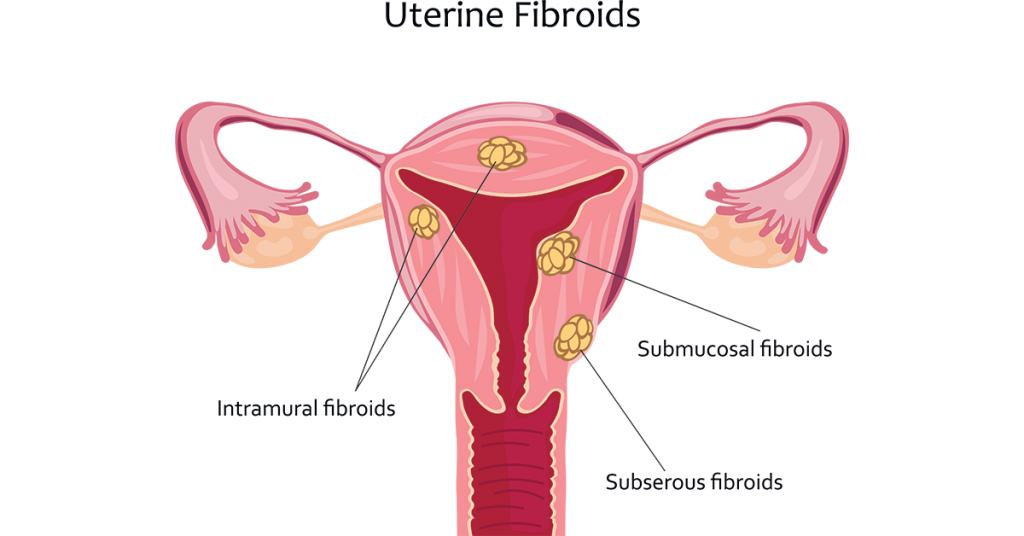What to Expect If You Have Uterine Fibroids

Uterine fibroids are benign growths in the uterus that develop during the reproductive years. Fibroids can range in size from tiny growths that are undetectable to the naked eye to large masses that enlarge the uterus or change its shape. There are three types of fibroids classified by where they grow:
- Intramural fibroids develop within the uterine wall.
- Submucosal fibroids bulge into the uterine cavity.
- Subserosal fibroids project outside of the uterus.
Uterine fibroids are not linked to an increased risk of developing uterine cancer. In fact, many women have fibroids at some point without even knowing it because they are asymptomatic, or don’t cause symptoms. According to the U.S. Office on Women’s Health, as many as 80% of women may develop fibroids by the time they reach 50. So, what can you expect if you develop fibroids?
Symptoms
Some women have uterine fibroids and do not experience any symptoms. If symptoms are present, they can vary based on the size and location of the fibroids. The number of fibroids present may also affect symptoms. You should see your doctor if you have the following common symptoms:
- Heavy menstrual bleeding
- Pelvic pressure or pain
- Prolonged menstrual periods
- Frequent Urination
- Backaches
Diagnosis
Your doctor can diagnose uterine fibroids using several different tests. If fibroids are asymptomatic, they are usually found during a routine exam. However, if you have symptoms, you should see your physician before your next routine exam.
Pelvic Exam
Uterine fibroids can be found during routine pelvic exams. This is especially true if the fibroids are not causing noticeable symptoms or if symptoms have been attributed to another condition. The doctor can feel irregularities in the shape of the uterus during a pelvic exam, which indicates that fibroids may be present.
Ultrasounds
If your doctor wants confirmation of the findings of the pelvic exam, they may order an ultrasound to get a picture of the uterus. An ultrasound uses sound waves to produce a picture o the uterus. The doctor or ultrasound tech will move a device called a transducer over your abdomen for an abdominal ultrasound. A transvaginal ultrasound may be needed to get better images, in which case the transducer is inserted into the vagina. Not only can the ultrasound confirm a diagnosis, but images produced during an ultrasound can also be used to measure and more accurately map fibroids.
Lab Tests
If your symptoms include heavy or abnormal bleeding, the doctor may order blood tests. A complete blood count (CBC) can determine whether or not you are anemic due to blood loss. Other blood tests may be performed to rule out conditions that cause similar symptoms to fibroids such as thyroid disorders and bleeding disorders.
Imaging tests
In some cases, ultrasounds images are not sufficient to diagnose or determine the size and location of fibroids. Imaging studies may be ordered for a more detailed view of the uterus.
- Magnetic resonance imaging (MRI)
- Hysterosonography
- Hysterosalpingography
Treatment Options
Fibroids that do not cause symptoms usually don’t need treatment and watchful waiting is all that is needed. If symptoms are present the treatment will depend on several factors including the size, location, and number of fibroids. The woman’s desire to maintain fertility can also influence treatment plans. Some treatments merely manage symptoms while others shrink or remove the fibroids.
Medications
Medications will not get rid of fibroids but can manage symptoms.
- Gonadotropin-releasing hormone (GnRH) antagonists to stop menstruation and shrink fibroids
- Progestin-releasing IUD to provide symptom relief and prevent pregnancy
- Tranexamic acid to ease heavy periods
- Oral contraceptives to control bleeding
- NSAIDs for pain relief
Surgical Procedures
If fibroids are causing severe symptoms and fertility is not a concern, traditional surgical procedures are available including abdominal myomectomy and hysterectomy.
Noninvasive & Minimally Invasive Procedures
- MRI-guided focused ultrasound surgery (FUS)
- Radiofrequency ablation
- Laparoscopic or hysteroscopic myomectomy
- Endometrial ablation
Uterine Fibroid Embolization (UFE)
Uterine Fibroid Embolization is a minimally invasive procedure performed by a doctor called an interventional radiologist. During the procedure, the patient is put under conscious sedation. A catheter is inserted into the upper thigh or wrist to access the uterine artery. The doctor injects tiny round beads through the catheter and into the blood vessels feeding the fibroid. The beads will block blood flow to the fibroids, which causes them to shrink. When the fibroids shrink, symptoms are relieved.
UFE is a good treatment option for women who:
- Have fibroids that cause symptoms (asymptomatic fibroids usually don’t require treatment)
- Want to keep their uterus
- Are not good candidates for surgery
- Want to avoid surgery for other reasons
Preferred Vascular Group’s Women’s Fibroid & Vascular Center performs Uterine Fibroid Embolization (UFE) to provide patients with relief from the inconvenient and painful symptoms of fibroids.
—
If you would like to schedule an appointment at Preferred Vascular Group to have a consult with a Board-Certified physician or would like to have one of our highly trained care providers reach out to you, please click on a button below:
